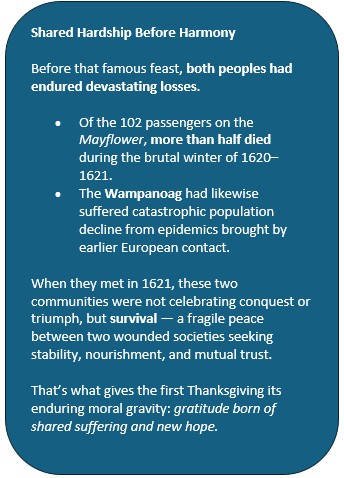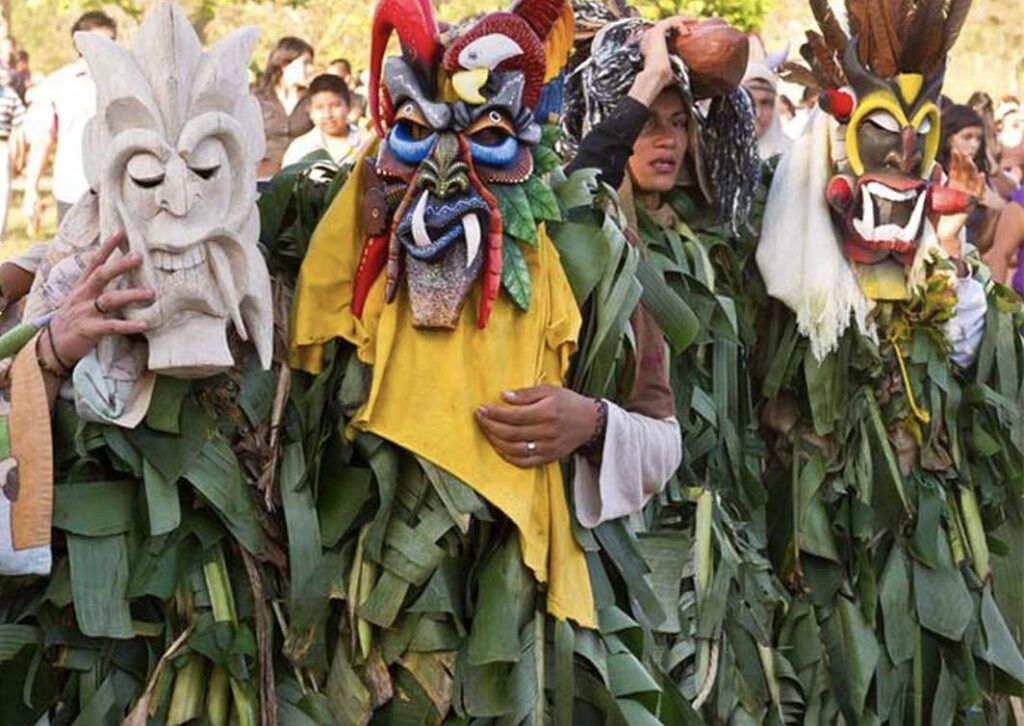Long before playlists, karaoke nights, or Guanacaste’s marimba rhythms drifted across the dry-season air, there was a historic — and unintentionally comic — musical encounter in New England.
It was March of 1621. The Pilgrims were exhausted survivors. The Wampanoag, led by Chief Massasoit, were cautious neighbors watching new arrivals who had landed in the middle of their ancestral territory.
Together, they created the first improvised cross-cultural jam session in the Americas — months before the first Thanksgiving feast.

The First Thanksgiving at Plymouth (Jean Leon Gerome Ferris, c. 1914)
Artist’s depiction of the 1621 harvest feast, where roughly fifty English settlers and ninety
Wampanoag men led by Massasoit shared three days of food, games, and peace.
(Public Domain — Library of Congress / Wikimedia Commons)
🥁 The Pilgrims Warm Up
When Massasoit and ninety of his men arrived at Plymouth, Governor Carver decided that hospitality demanded a show. Out came a dented signal trumpet and a single military drum — the colonial equivalent of a school band missing half its instruments.
“We brought out our drum and trumpet, and such as we had.”
— Edward Winslow, Mourt’s Relation (1622)
That phrase — “such as we had” — is Puritan self-deprecation at its best. Even Winslow knew their “band” wasn’t going to win any talent contests. But the gesture mattered. It was sound as diplomacy.
🪶 The Wampanoag Reply
Massasoit’s entourage responded in kind. Winslow noted they “made a great shout and sung many songs and danced.” The English watched, half-awed, half-bewildered, as Indigenous rhythm and movement transformed their stiff ceremony into something human, joyful, and alive.
Each group was equally amused — the Wampanoag by the metallic blare of English instruments, and the Pilgrims by the seamless percussion and chanting that needed no notation.
🌙 The Sleepless After-Party
A few months later, Winslow and Stephen Hopkins visited Massasoit’s home at Pokanoket. After supper, their hosts requested a song. The Pilgrims obliged — perhaps a solemn psalm. Then came the Wampanoag encore.
“They desired us to sing them some songs, which we did; and they in their kind began the like, making such a terrible noise that we could not possibly take any rest that night.”
— Edward Winslow, Mourt’s Relation
Translation: Great people, generous hosts, but next time, bring earplugs.
Even here, Winslow’s humor is disarming. His weary tone captures the cultural collision perfectly — Puritan restraint meets midnight celebration.
The Women Who Carried the Colony
Amid the hardship of that first Plymouth year, only four adult women survived the winter of 1620–1621:
Mary Brewster, Susanna Winslow, Elizabeth Hopkins, and Eleanor Billington.
Of them, Mary Brewster — wife of Elder William Brewster, the spiritual leader of the colony — is remembered as the matriarch of the Mayflower community.
In her fifties during the voyage, she endured the Atlantic crossing, hunger, and relentless cold, nursing the sick when half the colony perished.
When the harvest finally came, it was Mary Brewster’s hands and those of her few surviving companions that prepared the feast shared with Massasoit and the 90 Wampanoag men.
In the quiet grace of that act — after so much loss — gratitude became not just a ritual, but a kind of resilience.
“Mrs. Brewster lived to see her children’s children well settled in Plymouth, enjoying many mercies after all her sorrows.”
— William Bradford, Of Plymouth Plantation
These women’s endurance reminds us that the first Thanksgiving was not simply a meal — it was the recovery of hope.
⚖️ A Note Between the Lines
For roughly fifty years — until King Philip’s War (1675–76) — the Pilgrims and Wampanoag maintained an uneasy but genuine peace built on trade, diplomacy, and personal trust.
Their music wasn’t just entertainment; it was a fragile overture to coexistence in a world already scarred by loss.
🌾 Across the Tropics: A Different Kind of Thanksgiving
Meanwhile, far south in what is now Guanacaste, Costa Rica, another kind of cultural remix was unfolding.
During the same 1600s, Spanish settlers, African laborers, and Chorotega peoples began blending Catholic feast days with Indigenous harvest rituals. Out of this came a uniquely tropical gratitude season — the ancestors of today’s Guanacaste fiestas.

Fiesta de la Candelaria, Nicoya — a Guanacaste celebration of light, harvest,
and community that evolved from 17th-century cultural blending.
(Photo credit: La Teja / Grupo Nación — educational use)
Fiesta de la Candelaria (Nicoya)
The Spanish Candlemas merged with Indigenous harvest rites — a festival of light, maize, and music, celebrating abundance rather than conquest.
Día de San Isidro Labrador
Imported from Spain, San Isidro became the saint of Costa Rica’s rainy season — oxen, seeds, and farmers blessed in May processions that still echo a rural thanksgiving.
Fiesta de los Diablitos (Boruca & Rey Curré)
Indigenous communities flipped the colonial narrative. Dancers in carved wooden masks reenact the Spanish conquest — but in this version, the “devils” outwit the bull. It’s history retold as comedy, survival through rhythm and satire — their own Thanksgiving for endurance.
And beneath all of these traditions lies something profoundly human — the beauty of how cultures evolve, borrow, and blend to create lasting, positive traditions that link two old worlds into one shared celebration of life.

Boruca’s Fiesta de los Diablitos — a masked dance that reimagines the Spanish
conquest as celebration and survival, turning history into art and gratitude.
(Photo © James Kaiser / used for educational reference)
🪘 About That Marimba...
The marimba — now the heartbeat of Guanacaste — wasn’t actually around during the early 1600s.
It arrived later, in the 18th century, through Afro-Central American influences that blended African balafon traditions with Indigenous and Spanish craftwork.
In the 1600s, music in Guanacaste’s villages was made with clay drums, turtle shells, seed rattles, and wooden flutes, sometimes joined by a Spanish guitar or tambourine.
From the Pilgrims’ stiff trumpet calls to Guanacaste’s handmade drums and flutes, gratitude found its rhythm long before the marimba began to sing it.
By the 1800s, the marimba had become a living harmony of three civilizations: Indigenous, African, and European.
🎺 Harmony by Evolution
From Plymouth’s trumpets to Nicoya’s candlelight processions, music and gratitude evolved as languages of peace.
Neither side — in either hemisphere — found harmony on the first try.
But over generations, both learned to transform conflict into culture, and noise into meaning.
Four hundred years later, whether it’s a marimba in Guanacaste or a marching band in Massachusetts, the same lesson plays on:
Gratitude is the most universal rhythm we share.
✨ Moral of the Story
If your family’s Thanksgiving playlist feels chaotic, relax.
The first “Thanksgiving concert” already featured brass, drums, sleepless chanting — and a few thousand miles south, a masked devil dancing away colonial history.
Keep the beat, stay thankful, and remember:
joy and coexistence are always works in progress — but they sound better together.
Image Credits
Ferris, J. L. G. (1914). The First Thanksgiving at Plymouth 1621 [Painting]. Library of Congress. Public Domain.
La Teja (2024). Fiesta de la Candelaria, Nicoya [Photograph]. Grupo Nación.
Kaiser, J. (2016). Boruca Masks, Costa Rica [Photograph]. jameskaiser.com.

